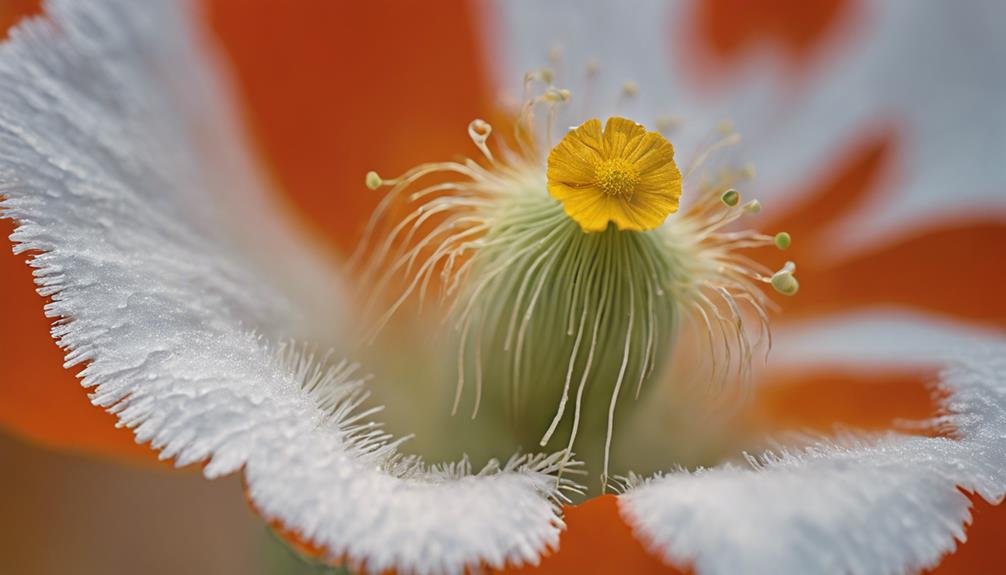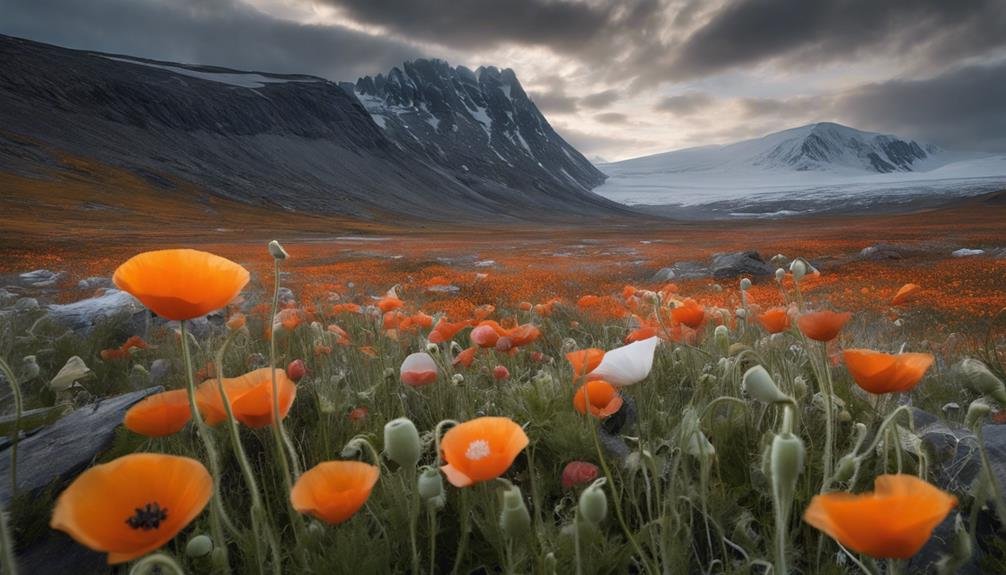Can the Arctic Poppy truly thrive in the harsh conditions of the Arctic? The answer is a resounding yes. The Arctic Poppy (Papaver radicatum), with its vibrant blooms, stands as a symbol of life’s tenacity even in the most extreme environments.
This remarkable plant has mastered the art of survival amidst the ice and cold. Its heliotropic flowers, covered in distinct black hairs, adeptly follow the sun across the sky, maximizing warmth and light exposure. Such an adaptation is crucial for its survival and reproduction in the challenging Arctic climate. The Arctic Poppy is found in rocky terrains and meadows, where it not only endures freezing temperatures but also employs its toxic properties as a defense against herbivorous threats. Its relationship with polar bees exemplifies nature’s intricate interdependencies, as these bees play a vital role in the poppy’s pollination process.
Understanding the Arctic Poppy’s resilience and ecological significance provides insight into the broader narrative of life’s adaptability in extreme conditions. This plant’s existence in the Arctic underscores the complexity and interconnectivity of ecosystems, emphasizing the importance of preserving such unique species and their habitats.
Key Takeaways
The Arctic Poppy (Papaver radicatum) showcases remarkable evolutionary adaptations, such as heliotropism and toxic properties, allowing it to thrive in the harsh Arctic environment. Its distinctive flower structure not only contributes to the area’s biodiversity but also aids in pollination by attracting polar bees, emphasizing its role in the ecosystem.
The survival of the Arctic Poppy in extreme conditions and its ecological importance underscore the necessity for ongoing research. This research is vital for understanding the species’ challenges and for devising protective measures for it and other Arctic flora. The Arctic Poppy’s endurance and contributions highlight the delicate balance within Arctic ecosystems, stressing the importance of continued study to preserve these natural phenomena.
Key Takeaways:
- The Arctic Poppy has evolved unique features like heliotropism and toxicity to survive in the Arctic.
- Its unique flower morphology aids in attracting polar bees for pollination, crucial for the ecosystem.
- Ongoing research is imperative to understand and protect the Arctic Poppy and other Arctic flora.
Arctic Bloom Overview
Adaptations of Arctic Poppies to Harsh Climates
The Arctic poppy, scientifically known as Papaver radicatum, is a testament to the resilience and adaptability of plant life in the face of extreme weather conditions. These plants flourish in the Arctic’s severe environment, showcasing nature’s ability to thrive. A standout feature of these plants is their heliotropic behavior. This fascinating adaptation involves the flowers’ movement to track the sun across the sky, optimizing sunlight absorption for photosynthesis during the brief Arctic summer.
Habitats and Ecological Niches
Papaver radicatum is versatile, growing in diverse Arctic landscapes such as meadows, mountainous areas, and arid riverbeds, with a notable presence in Nunavut, Canada. These poppies have an intrinsic ability to utilize the rocky, elevated terrains not just for protection against the elements but also to leverage the ground’s retained heat. This attribute is crucial for their survival and proliferation in an ecosystem where resources are scarce.
Unique Characteristics and Survival Mechanisms
Despite its beauty, the Arctic poppy has developed toxic properties as a defense mechanism against certain mammalian predators, ensuring its survival and continued propagation. The plant typically reaches heights of 10-15 cm and is distinguished by its vibrant yellow or white petals and a coat of black hairs, features that aren’t merely for aesthetic appeal but serve practical purposes in the plant’s survival strategy. These characteristics underscore the Arctic poppy’s remarkable adaptation abilities, making it a species of great interest in studying plant resilience in extreme environments.
Flower Morphology

Delving into the Morphology of the Arctic Poppy
The Arctic Poppy (Papaver radicatum), a resilient flower thriving in the harsh climates of the Arctic, possesses unique morphological features that facilitate its survival. Let’s explore these remarkable adaptations that underscore the plant’s resilience.
Petals that Capture Warmth
The Arctic Poppy is adorned with four bright yellow or white petals. These petals aren’t just for show; they cleverly form a cup-like shape that plays a pivotal role in the plant’s survival. This structure is adept at capturing and retaining warmth, effectively creating a microenvironment that’s significantly warmer than the surrounding air. This warmth is essential for the plant’s processes, especially given its cold surroundings.
Insulation Through Hairs
A notable feature of the Arctic Poppy is the presence of hair-like structures that cover the plant, including the sepals that envelope the petals. These hairs are more than just a feature for aesthetics; they provide critical insulation. This insulation is vital for heat retention, offering a buffer against the cold, windy conditions typical of the Arctic environment.
Sun Tracking for Optimal Light
The Arctic Poppy exhibits heliotropism, an adaptation that allows it to grow towards the sunlight. This capability ensures that the plant maximizes its exposure to sunlight, crucial for photosynthesis. The petals themselves contribute to this adaptation by reflecting sunlight towards the center of the flower, where the pistil (the female reproductive part) is located. This concentration of light not only aids in photosynthesis but also ensures that the plant remains warm and promotes efficient pollination.
These features—the cup-shaped petals for capturing warmth, the insulating hairs for heat retention, and the sun-tracking ability—highlight the Arctic Poppy’s remarkable adaptations. These adaptations are a testament to the plant’s resilience and its ability to thrive in one of the planet’s most extreme climates.
Arctic Regions

Adapting to the Arctic: The Remarkable Papaver radicatum**
In the vast and cold expanses of the Arctic, where the landscape is dominated by rocky, gravelly, and well-drained soils, a special plant thrives against the odds. Papaver radicatum, commonly known as the Arctic poppy, is a testament to the power of adaptation and survival. This plant has mastered the art of living in the harshest conditions, from Alaska to Greenland, and across parts of Europe and Asia.
Diverse Subspecies: A Spectrum of Adaptation
The Arctic poppy isn’t a one-size-fits-all species. It comprises several subspecies, including Papaver alaskanum, Papaver mcconnellii, and Papaver lapponicum. Each of these subspecies has evolved unique characteristics that allow them to thrive in specific Arctic and alpine environments. The variation in size and habitat preference among these subspecies highlights the plant’s remarkable ability to adapt to different conditions.
Surviving in Extreme Conditions: The Evolutionary Edge
The white blooms of the Arctic poppy aren’t just beautiful; they’re a symbol of evolutionary success. This characteristic is a response to the challenges of living in a cold and harsh environment. The color helps to attract the limited pollinators available in such extreme conditions, ensuring the survival and continuation of the species.
A Wide Geographical Embrace
The ability of Papaver radicatum to adapt is further demonstrated by its wide distribution. Its presence in multiple continents within the Arctic and alpine zones is a clear indication of its versatility and specialized ecological niche. This wide adaptability is a testament to the plant’s success in navigating the challenges of the Arctic regions.
In the Arctic’s demanding environments, Papaver radicatum stands out as a symbol of resilience and adaptability. Its widespread distribution across diverse terrains and its ability to evolve subspecies tailored to specific conditions underscore its remarkable ecological success.
Polar Bee Attraction

Early Spring Awakening: The Vital Role of Bombus Polaris
In the brisk Arctic spring, Bombus polaris emerges as a key player in the natural world. This period marks the beginning of a vital relationship with the Arctic Poppy (Papaver radicatum), as these bumblebees start their pollination activities. The timing is impeccable; as the snow recedes, the Arctic Poppy blooms, relying on Bombus polaris for its reproductive success. This early interaction sets the stage for the season’s ecological dynamics, showcasing the bumblebee’s indispensable role in the Arctic ecosystem.
Seasonal Shifts: The Changing Guards of Pollination
As the Arctic summer unfolds, the dominance of Bombus polaris in the pollination process sees a gradual transition. Flies take center stage, becoming the primary pollinators of the Arctic Poppy. This shift underscores the adaptability of the Arctic ecosystem, where multiple pollinators contribute to the lifecycle of plants. Understanding this change is pivotal for conservation strategies, emphasizing the need to protect a diverse range of pollinators to ensure the resilience of Arctic flora.
Conservation Through Understanding: The Pollinator-Plant Relationship
The intricate dance between Papaver radicatum and its pollinators, spearheaded by Bombus polaris, is more than a mere seasonal occurrence—it’s a critical ecological process. The successful reproduction of the Arctic Poppy hinges on these interactions, highlighting the broader implications for Arctic biodiversity. Recognizing the value of these relationships is a cornerstone of conservation efforts, aiming to preserve the delicate balance of life in one of the planet’s most extreme environments.
Vulnerable Status Indicators

Adaptability of the Arctic Poppy in Harsh Climates
The Arctic poppy stands out for its remarkable resilience in one of the planet’s most extreme environments. Its vivid yellow petals serve a critical function in attracting the limited pollinators available in its Arctic setting. This unique adaptation highlights the importance of sustained conservation efforts to preserve the intricate ecological balance within which the Arctic poppy thrives.
Conservation Efforts and Population Stability
Thanks to dedicated conservation initiatives, the Arctic poppy’s population remains stable, underscoring the species’ adaptability and the success of current habitat protection strategies. The concerted efforts of conservationists play a crucial role in maintaining the equilibrium necessary for the poppy’s continued survival amidst the challenges posed by its harsh habitat.
Monitoring Climate Impacts on the Arctic Poppy
With the Arctic undergoing significant climatic alterations, the scientific community is on high alert, closely monitoring environmental factors that could impact the Arctic poppy. Key focus areas include tracking temperature fluctuations, ice melt rates, and shifts in pollinator activity. These factors are critical in assessing the potential risks climate change poses to the poppy’s ability to reproduce and sustain its populations in the wild.
Through vigilant monitoring and ongoing research, scientists aim to safeguard the Arctic poppy, ensuring its survival against the backdrop of an evolving Arctic landscape.
Frequently Asked Questions
What Is Special About the Arctic Poppy?
Q: What makes the Arctic poppy special?
A: The Arctic poppy is distinguished by its ability to track the sun, its bright colors, and its resilience to extreme cold. These attributes help attract pollinators, vital for its survival in severe environments. Its adaptations are key to its resilience and ecological significance.
How Tall Do Arctic Poppies Grow?
Q: How tall do Arctic poppies grow?
A: Arctic poppies typically grow to heights between 10-15 cm. They flourish in well-drained, gravelly soils and have vibrant flowers during their short flowering season, adapting well to their harsh growing conditions to efficiently absorb sunlight.
Can You Eat Arctic Poppy?
Is it safe to eat Arctic Poppy?
No, consuming Arctic Poppy is not recommended because it contains toxic alkaloids that can pose health risks. While it might have nutritional aspects, the dangers associated with these substances make it an unsuitable choice for food. There are safer alternatives available for those looking for edible plants.
Where Can Arctic Poppies Be Found?
Where can you find Arctic Poppies?
Arctic poppies are found in cold regions, particularly in the alpine and arctic zones of Europe, North America, and Asia. These flowers are adapted to thrive in harsh climates.
Conclusion
The Arctic Poppy (Papaver radicatum) is an extraordinary example of how plant species have evolved to thrive in extreme environments. Its adaptations, including heliotropism and toxic properties, are key to its survival in the unforgiving Arctic climate. The distinct flower morphology of the Arctic Poppy not only adds to the biodiversity of the region but also plays a crucial role in attracting polar bees for pollination, highlighting its significance in the ecosystem.
Despite its resilience, concerns regarding its vulnerability emphasize the importance of continued research. This will help in understanding the challenges it faces and in developing strategies to protect this and other Arctic species. The Arctic Poppy’s ability to endure and its ecological contributions illustrate the intricate balance of Arctic flora, underlining the need for further in-depth investigation to safeguard these natural wonders.


0 Comments